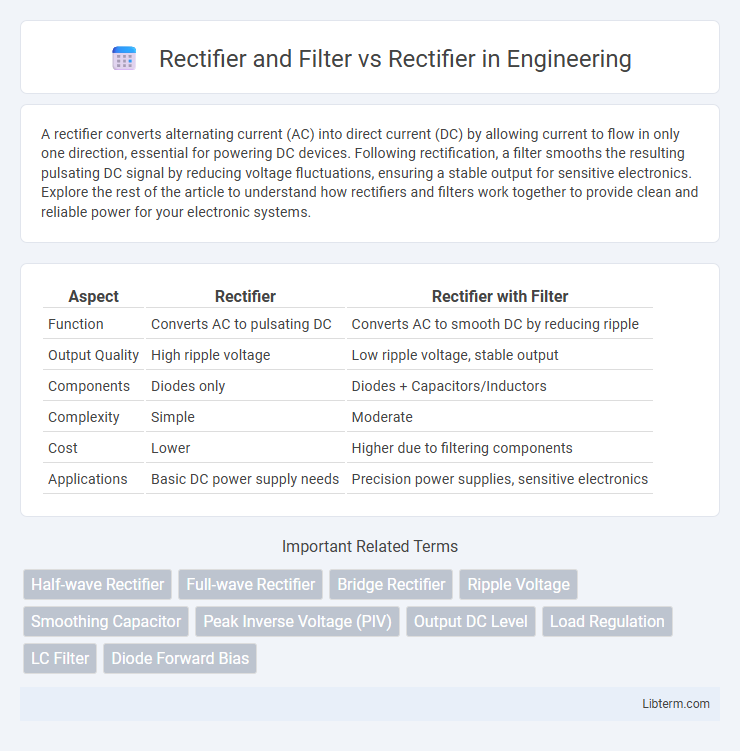A rectifier converts alternating current (AC) into direct current (DC) by allowing current to flow in only one direction, essential for powering DC devices. Following rectification, a filter smooths the resulting pulsating DC signal by reducing voltage fluctuations, ensuring a stable output for sensitive electronics. Explore the rest of the article to understand how rectifiers and filters work together to provide clean and reliable power for your electronic systems.
Table of Comparison
| Aspect | Rectifier | Rectifier with Filter |
|---|---|---|
| Function | Converts AC to pulsating DC | Converts AC to smooth DC by reducing ripple |
| Output Quality | High ripple voltage | Low ripple voltage, stable output |
| Components | Diodes only | Diodes + Capacitors/Inductors |
| Complexity | Simple | Moderate |
| Cost | Lower | Higher due to filtering components |
| Applications | Basic DC power supply needs | Precision power supplies, sensitive electronics |
Introduction to Rectifiers
Rectifiers are essential electronic devices that convert alternating current (AC) to direct current (DC) by allowing current flow in only one direction, a process crucial for powering DC electronic circuits. A pure rectifier outputs pulsating DC with ripples, necessitating the use of filters, such as capacitors or inductors, to smooth the voltage and reduce fluctuations for sensitive applications. Understanding the distinction between rectifiers alone and rectifiers combined with filters is fundamental for optimizing power supply performance in various electronic systems.
Types of Rectifiers
Types of rectifiers include half-wave, full-wave, and bridge rectifiers, each differing in efficiency and waveform output. Half-wave rectifiers utilize a single diode for converting AC to pulsating DC, while full-wave rectifiers use two diodes with a center-tapped transformer, improving the output's smoothness. Bridge rectifiers employ four diodes arranged in a bridge configuration, providing full-wave rectification without requiring a center-tapped transformer, resulting in better voltage output and efficiency in power supply applications.
Working Principle of a Rectifier
A rectifier is an electronic device that converts alternating current (AC) into direct current (DC) by allowing current to flow in only one direction using diodes or semiconductor components. The working principle of a rectifier relies on the nonlinear characteristic of diodes, which conduct during positive half-cycles of AC and block current during negative half-cycles, producing a pulsating DC output. When combined with a filter, the rectifier's pulsating DC is smoothed into a more stable DC voltage by removing ripples through components like capacitors or inductors.
Limitations of Pure Rectifiers
Pure rectifiers convert AC to pulsating DC but produce significant voltage ripple, causing inefficiency in powering sensitive electronic devices. Without filters, rectifier outputs have low power quality and limited smoothness, leading to increased electromagnetic interference and reduced component lifespan. Filters improve DC output stability by reducing ripple voltage, enhancing the performance and reliability of power supplies.
Introduction to Filters in Power Supplies
Rectifiers convert alternating current (AC) to direct current (DC), but the output contains ripples that are unsuitable for sensitive electronic devices. Filters in power supplies smooth this pulsating DC by reducing voltage fluctuations and noise, enhancing the quality of the DC output. Common filter components include capacitors, inductors, and resistors, which together help stabilize voltage and improve overall power supply performance.
Rectifier vs Rectifier with Filter: Key Differences
Rectifiers convert AC to DC by allowing current to flow in one direction, producing a pulsating DC output with significant ripple. Rectifiers combined with filters use capacitors or inductors to smooth the output, significantly reducing voltage fluctuations and providing a more stable DC signal. This difference enhances performance in electronic circuits requiring consistent voltage, such as in power supplies and battery charging applications.
Output Waveform Comparison: Rectifier vs Filtered Rectifier
A rectifier converts AC to pulsating DC, producing an output waveform with significant ripple and distinct peaks corresponding to the input frequency. A filtered rectifier incorporates components like capacitors or inductors to smooth this output, reducing ripple amplitude and delivering a steadier DC voltage. Comparing the two, the filtered rectifier's waveform exhibits a more constant voltage level with minor fluctuations, crucial for sensitive electronic devices requiring stable power supplies.
Importance of Filtering in Rectifier Circuits
Filtering in rectifier circuits is essential for converting pulsating DC output into smooth and stable DC voltage, significantly reducing the ripple factor and improving performance. Capacitor filters, inductor filters, and LC filters play a critical role in maintaining voltage consistency and protecting sensitive electronic components from voltage fluctuations. Effective filtering enhances the efficiency and reliability of power supplies in applications from consumer electronics to industrial systems.
Applications: Where to Use Pure Rectifier vs Filtered Rectifier
Pure rectifiers are ideal for applications requiring only the conversion of AC to pulsating DC, such as simple battery charging or basic power supplies where voltage ripple is tolerable. Filtered rectifiers are essential in sensitive electronic devices, audio equipment, and DC motor drives where a smooth, stable DC voltage is necessary to ensure optimal performance and minimize noise. Choosing between them depends on the tolerance for ripple noise and the precision of the DC output required in the specific application.
Summary: Choosing Between Rectifier and Rectifier with Filter
Selecting between a plain rectifier and a rectifier with filter depends on the desired output quality; a rectifier converts AC to pulsating DC, while a rectifier with filter produces smoother, more stable DC voltage. Applications requiring stable power supply, such as audio equipment or sensitive electronics, benefit from the reduced ripple provided by the filter. The choice impacts efficiency, complexity, and cost, with filter designs enhancing performance but increasing component count and size.
Rectifier and Filter Infographic

 libterm.com
libterm.com